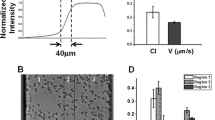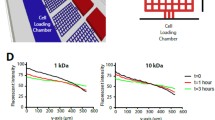Abstract
Neutrophils migrating in tissue respond to complex overlapping signals generated by a variety of chemotactic factors (CFs). Previous studies suggested a hierarchy between bacteria-derived CFs and host-derived CFs but could not differentiate neutrophil response to potentially equal host-derived CFs (IL-8 and LTB4). This paper reports neutrophil migration in conflicting gradients of IL-8 and LTB4 using a microfluidic chemotaxis device that can generate stable and well-defined gradients. We quantitatively characterized the movement of cells from time-lapse images. Neutrophils migrate more efficiently toward single IL-8 gradients than single LTB4 gradients as measured by the effective chemotactic index (ECI). In opposing gradients of IL-8 and LTB4, neutrophils show obvious chemotaxis toward a distant gradient, consistent with previous reports. When an opposing gradient of LTB4 is present, neutrophils show less effective chemotaxis toward IL-8 than when they are in a gradient of IL-8 alone. In contrast, the chemotactic response of neutrophils to LTB4 is not reduced in opposing gradients as compared to that in a single LTB4 gradient. These results indicate that the presence of one host-derived CF modifies the response of neutrophils to a second CF suggesting a subtle hierarchy between them.
Similar content being viewed by others
References
Baggiolini, M. Chemokines and leukocyte traffic. Nature 392:565–568, 1998.
Behar, T. N., A. E. Schaffner, C. A. Colton, R. Somogyi, Z. Olah, C. Lehel, and J. L. Barker. GABA-induced chemokinesis and NGF-induced chemotaxis of embryonic spinal cord neurons. J. Neurosci. 14:29–38, 1994.
Boyden, S. V. The chemotactic effect of mixtures of antibody and antigen on polymorphonuclear leukocytes. J. Exp. Med. 115:453, 1962.
Chung, C. Y., S. Funamoto, and R. A. Firtel. Signaling pathways controlling cell polarity and chemotaxis. Trends Biochem. Sci. 26:557–566, 2001.
Crooks, S. W., and R. A. Stockley. Leukotriene B4. Int. J. Biochem. Cell Biol. 30:173–178, 1998.
Dekker, L. V., L. V. Dekker, and A. W. Segal. Signal transduction: Signals to move cells. Science 287:982–985, 2000.
Dertinger, S. K. W., D. T. Chiu, N. L. Jeon, and G. M. Whitesides. Generation of gradients having complex shapes using microfluidic networks. Anal. Chem. 73:1240–1246, 2001.
Foxman, E. F., J. J. Campbell, and E. C. Butcher. Multistep navigation and the combinatorial control of leukocyte chemotaxis. J. Cell Biol. 139:1349–1360, 1997.
Foxman, E. F., E. J. Kunkel, and E. C. Butcher. Integrating conflicting chemotactic signals: The role of memory in leukocyte navigation. J. Cell Biol. 147:577–588, 1999.
Glading, A., D. A. Lauffenburger, and A. Wells. Cutting to the chase: Calpain proteases in cell motility. Trends Cell Biol. 12:46–54, 2002.
Heit, B., S. Tavener, E. Raharjo, and P. Kubes. An intracellular signaling hierarchy determines direction of migration in opposing chemotactic gradients. J. Cell Biol. 159:91–102, 2002.
Jeon, N. L., S. K. W. Dertinger, D. T. Chiu, I. S. Choi, A. D. Stroock, and G. M. Whitesides. Generation of solution and surface gradients using microfluidic systems. Langmuir 16:8311–8316, 2000.
Knapp, D. M., E. F. Helou, and R. T. Tranquillo. A fibrin or collagen gel assay for tissue cell chemotaxis: Assessment of fibroblast chemotaxis to GRGDSP. Exp. Cell Res. 247:543–553, 1999.
Kubes, P. Introduction: The complexities of leukocyte recruitment. Semin. Immunol. 14:65–72, 2002.
Lin, F., C. M. C. Nguyen, S. J. Wang, W. Saadi, S. P. Gross, and N. L. Jeon. Effective neutrophil chemotaxis is strongly influenced by mean IL-8 concentration. Biochem. Biophys. Res. Commun. 319:576–581, 2004.
Nelson, R. D., P. G. Quie, and R. L. Simmons. Chemotaxis under agarose: A new and simple method for measuring chemotaxis and spontaneous migration of human polymorphonuclear leukocytes and monocytes. J. Immunol. 115:1650–1656, 1975.
Olson, T. S., and K. Ley. Chemokines and chemokine receptors in leukocyte trafficking. Am. J. Physiol. Regulat. Integr. Comp. Physiol. 283:R7–R28, 2002.
Parent, C. A., B. J. Blacklock, W. M. Froehlich, D. B. Murphy, and P. N. Devreotes. G protein signaling events are activated at the leading edge of chemotactic cells. Cell 95:81–91, 1998.
Ridley, A. J. Rho family proteins: Coordinating cell responses. Trends Cell Biol. 11:471–477, 2001.
Woolhouse, I. S., D. L. Bayley, and R. A. Stockley. Sputum chemotactic activity in chronic obstructive pulmonary disease: Effect of {alpha}1-antitrypsin deficiency and the role of leukotriene B4 and interleukin 8. Thorax 57:709–714, 2002.
Zigmond, S. Ability of polymorphonuclear leukocytes to orient in gradients of chemotactic factors. J. Cell Biol. 75:606–616, 1977.
Zigmond, S. H. How WASP regulates actin polymerization. J. Cell Biol. 150:117F–120F, 2000.
Author information
Authors and Affiliations
Corresponding author
Rights and permissions
About this article
Cite this article
Lin, F., Nguyen, C.MC., Wang, SJ. et al. Neutrophil Migration in Opposing Chemoattractant Gradients Using Microfluidic Chemotaxis Devices. Ann Biomed Eng 33, 475–482 (2005). https://doi.org/10.1007/s10439-005-2503-6
Received:
Accepted:
Issue Date:
DOI: https://doi.org/10.1007/s10439-005-2503-6




